Uncover Orange's vibrant flavors and culinary gems with our expert guides. Plan an unforgettable trip now!
Read more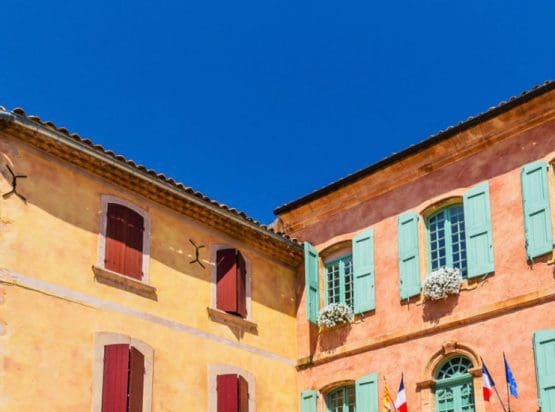
EXPLORE ALL OUR RHôNE VALLEY WINE REGION GUIDES
Last updated: April 4, 2025
First-time visitors to the southern Rhône anticipate a plethora of concentrated reds: unctuous wines baked under the Provençal sun and picked at optimum ripeness. In some instances, that is precisely what the region delivers.
Yet, one can discover a world of variety here, with producers making excellent white, rosé, and even dessert styles. Beaumes-de-Venise, a hitherto unknown part of the viticultural landscape, is one such region that wears its chameleon colors with pride. Indeed, Beaumes-de-Venise was marketing delicious, sweet wines long before dry reds became the height of fashion.
However, consumers rejected this venerable style en masse in the 20th century, so the appellation had to evolve. It has redefined itself as a source of exceptional reds that boast all of the perfume and potency of its far larger neighbor. Make no mistake: this is a region in the ascendant. It merits a closer inspection.
Discover More About French Wine
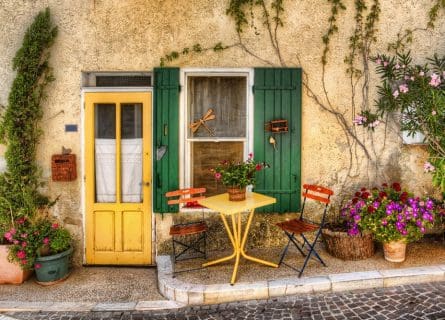
The great expanse of land south of Montelimar, including the area now known as the southern Rhône Valley, has been colonized since the days of ancient Greece.
Historians believe that after Greek mariners founded Marseille in 600 BC, they developed Beaumes-de-Venise – and neighboring settlements – as spa resorts for wealthy clientele. They were also responsible for introducing the star white grape of the appellation Muscat Blanc a Petit Grains.
Meanwhile, they continued establishing trading ports along the Mediterranean, including St-Tropez, Nice, and Antibes. Yet a rising power in central Italy was about to redefine Europe’s geopolitical map for the next 600 years.
Roman Conquest and Cultural Transformation
In 125 BC, ambitious Roman generals seized their chance to conquer Gaul’s southern Mediterranean region. The catalyst was the siege of Marseille (known as Massalia), threatened by a rival force of Celto-Ligurians; the Romans were, ironically enough, invited into the region to fight alongside the Greeks.
However, after the Romans pushed the Ligurians out of southern France, they quickly subjugated the entire province. The remaining Greek settlers either fled or became part of Provincia Romana, ruled over by Rome’s administrators as part of the Western Empire. During this era, people across the land celebrated the sweet wines of Beaumes-de-Venise.
However, they would horrify modern-day consumers; the Romans would adulterate their wines with seawater and herbs, heating this potent concoction over flames to maderize the alcohol. The result could best be described as ‘Muscat Fumé.’
Medieval Developments and the Papal Influence
After the collapse of the Western Roman Empire in AD 476, the Vandals, Burgundians, and Visigoths all passed through southern France before it came under Frankish control.
Several centuries later, the papacy relocated to Avignon after huge schisms in Rome. Seven successive popes built lavish monuments to Catholicism, including the papal palace in Avignon. According to legend, the French king Louis IX requested supplies of Beaumes-de-Venise to aid his journey to the Holy Land during the 7th Crusade. Under the stewardship of Pope Clement V, the acreage in Beaumes-de-Venise increased dramatically to satisfy the demand of the pope’s inner circle at Avignon.
The city remained a papal city-state until 1791. The aftermath of the French Revolution saw great intolerance for self-governing territories within France.
Modern Recognition and Diversification
Beaumes-de-Venise, meanwhile, was awarded appellation status in 1945. For most of the 20th century, the zone staked its reputation on powerful and aromatic Muscat Vin Doux Naturel: a potent concoction of acidity and sweetness.
But recently, red blends from Beaumes-de-Venise have also come to the fore as growers continue to exploit their superior soils and the trend for quality labels that show a sense of place. But more importantly, the market for dessert wines, sadly, remains minute.
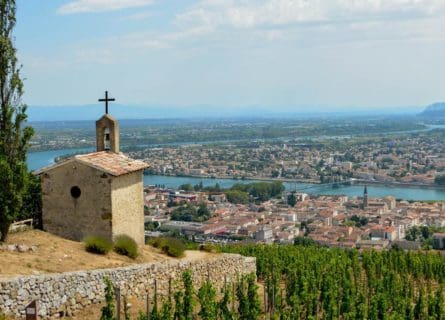
Beaumes-de-Venise is undoubtedly the most “recherché” of the Rhône’s wine villages. The area under vine is situated east of Orange, a few kilometers from the river. The most iconic landmark is the Canal du Carpentras, which runs its course to the town of Carpentras in the south, passing through Beaumes-de-Venise in the process. Builders constructed it to enable growers to irrigate their crops in particularly dry years, conditions that are unfortunately happening more frequently.
Adapting Viticulture to a Harsh Mediterranean Climate
Indeed, only robust grape varieties can thrive in this sweltering Mediterranean climate – temperatures in July and August will often exceed 95 degrees. How do producers maintain freshness and acidity in their wines? The secret lies in elevation and aspect; growers plant the best climats (vineyard sites) at higher altitudes, facing south.
This facilitates exposure to the morning sunlight while avoiding the harsher UV rays of the afternoon. Winegrowers are also careful to select the coldest soils in the region: late Jurassic limestone that is both porous and permeable. Warmer alluvial soils dominate lower-lying vineyards, producing wines with less acidity and weight.
Unofficial Hierarchies and Inspiration from Burgundy
Mirroring the situation in the northern Rhône, the authorities have never undertaken a hierarchical classification of the best soils and sites found south of Montelimar. Nevertheless, there is an unofficial list of top-performing climats in every appellation. Beaumes-de-Venise is no exception: the fetishization of single-site wines has become widespread in the zone as growers look to Burgundy for inspiration.
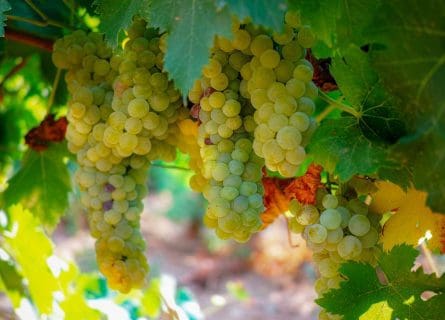
Beaumes-de-Venise offers two very distinct styles of wine. Since the 1300s, producers have made the sweet Muscat (promoted under a separate appellation), an aromatic blend of Muscat Blanc à Petit Grains and Muscat Noir. Like Port and Madeira, the grape spirit is added during fermentation, halting the yeast from turning all the sugar in the must into alcohol.
As a result, pickers only harvest very ripe bunches in the late fall, and the appellation rules mandate a minimum sugar level of 252 grams per liter in the juice.
Sold with a minimum abv of 15%, the wines can rival Sauternes in complexity and longevity. Older bottles, in particular, are dazzling, infused with aromas of acacia honey, stone fruit, and quince.
Stylistic Influences and Regulations for Reds
Stylistically, the reds borrow from Châteauneuf-du-Pape and Gigondas: a good example is the former’s concentration, freshness, and poise. According to the appellation framework, Grenache must contribute at least 50% of the final blend, with Syrah potentially finalizing the cuvée.
However, winemakers can also incorporate Rhône grape varieties like Cinsault and Terret Noir, provided they do not exceed 25%. Mono-varietal styles are rare in the region, as growers prefer to blend for complexity.
Exceptional Value and Complexity
Today, Beaumes-de-Venise can bring exceptional value to your table. The appellation lacks the global renown of its neighbors, which has kept prices very reasonable.
But the wines can soar – imagine a magnificently complex and velvety example of Grenache, complemented by Syrah’s grip and acidity. The wines are typically fruit-forward, with red berries, white pepper, and garrigue aromas. With age, you can expect leather, tobacco, and gamey notes on the palate. A quintessential Rhône wine experience!
Châteauneuf-du-Pape, the star of the southern Rhône, needs little introduction. It has produced superlative and heady red wines in southeastern France for centuries.
However, what is less commonly known is that a network of communes to the east and west surrounds the appellation, each offering a unique interpretation of the local soils and climate. For several reasons, Beaumes-de-Venise has become one of the most important of these up-and-coming vineyards.
Investment and Quality
Chief among these is the level of investment that has poured into the zone in recent years, raising the quality bar to unprecedented heights. Long regarded as France’s best dessert Muscat, Beaumes-de-Venise was nonetheless regarded as a humdrum producer of Grenache-based red wines.
But that is no longer the case: top blends can be linear, voluptuous, overtly concentrated, or very subtle. Yet remarkably few poor wines are being made today, certainly compared to 20 years ago. They have a lovely brightness of flavor and depth of fruit that makes them stand out.
Organic and Sustainable Practices Shaping the Future
Meanwhile, the organic and sustainable movement is now big business in the southern Rhône. Organic viticulture eschews all (synthetic) vine treatments, emphasizing practicing agriculture in harmony with natural rhythms.
Does that sound a bit wishy-washy? It is nothing of the sort: many of the region’s best reds and whites have been produced this way for over a decade. Moreover, conversions increase yearly as growers realize that sustainable wine is a marketable commodity.
Surpassing Expectations
Yet, even today, naysayers will still insist that Beaumes-de-Venise is a decent value facsimile of Châteauneuf-du-Pape, using much the same red grapes. But they’re wrong: the appellation has become one of the Rhône’s superstars, exporting classical dessert wines and seductive reds. It’s the intelligent choice for the anti-wine snob.
Muscat blanc is a white wine grape varietal popular in the Muscat d'Alsace, Moscato d'Asti and Beaumes-de-Venise regions.
Find out moreDiscover grenache, a mediterranean grape that is dark-skinned red wine grape variety and an unlikely hero of a grape
Find out moreSyrah is dark-skinned and perhaps the most underrated of the 'noble' red grape varieties.
Find out moreMourvèdre is a red wine grape variety of mysterious origin that's grown around the world, including the Rhone and Provence regions of France.
Find out moreExceptional restaurants – informal and chic – abound in the Vaucluse. Indeed, Provence’s food culture has no equal in the Mediterranean, and top chefs always source their ingredients from the area’s rich selection of open-air markets. Walking around these bustling centers of commerce and gastronomy is a feast for the senses: vendors hawk all manner of organic fruit and vegetables, in addition to fresh herbs, lavender, seafood, and meat from the Camargue.
Meanwhile, you must book ahead to secure a table at one of Avignon’s best destination restaurants, particularly in the summer. Our top choice? A bottle of Beaumes-de-Venise red with slow-cooked Provençal lamb shoulder. Arrive hungry.
A Gastronomic Guide to the Provençal Cuisine: Read more

Uncover Orange's vibrant flavors and culinary gems with our expert guides. Plan an unforgettable trip now!
Read more
Uncover Aix-en-Provence's vibrant flavors and culinary gems with our expert guides. Plan an unforgettable trip now!
Read more
Uncover Antibes' vibrant flavors and culinary gems with our expert guides. Plan an unforgettable trip now!
Read more
Uncover Avignon's vibrant flavors and culinary gems with our expert guides. Plan an unforgettable trip now!
Read more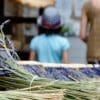
Uncover Gigondas's vibrant flavors and culinary gems with our expert guides. Plan an unforgettable trip now!
Read more
Uncover Marseille's vibrant flavors and culinary gems with our expert guides. Plan an unforgettable trip now!
Read more
Uncover NIce's vibrant flavors and culinary gems with our expert guides. Plan an unforgettable trip now!
Read moreIf you would like us to customize an exclusive luxury tour, contact us and let us know your travel plans. We offer luxury food and wine tours for private groups of a mininium two guests. In addition, all of our private, chauffeured tours are available year-round upon request.

